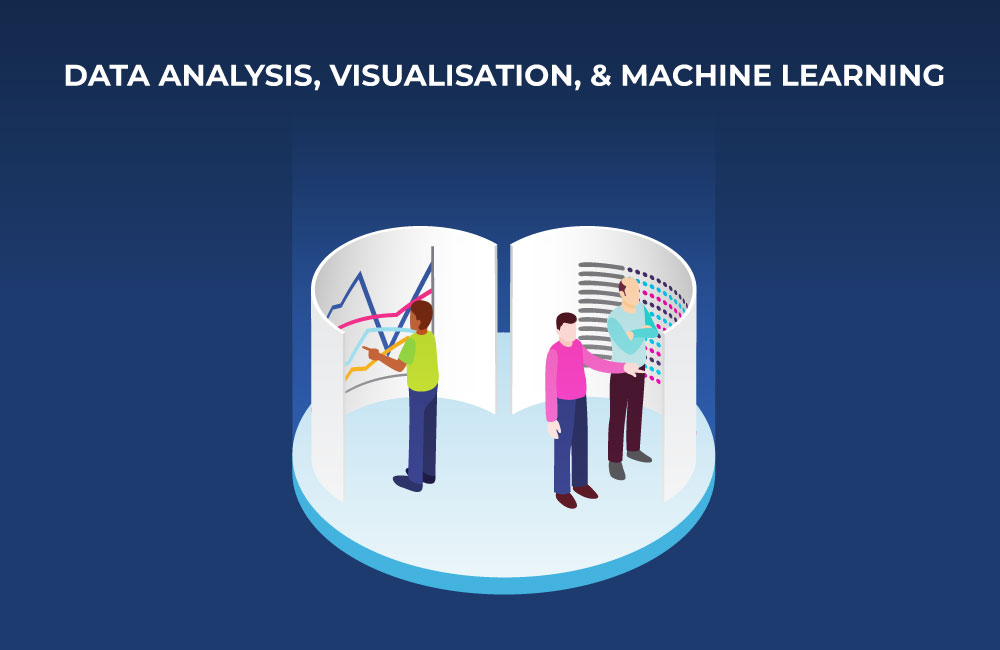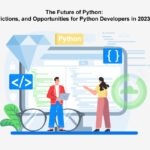How to Use Python Libraries and Frameworks for Data Analysis, Visualisation, and Machine Learning
Python has seen a remarkable evolution, transitioning from a multipurpose programming language to a competitor in the field of data science. Leveraging its expansive collection of libraries and frameworks, professionals can now dissect data, create illuminating visual representations, and construct intricate machine-learning models. Harnessing the potential of Python empowers both individuals and organizations to uncover the hidden potential within data, sparking innovation across diverse domains. Consequently, Python presents a realm of prospects for anyone intrigued by data analysis, visualization, or machine learning, regardless of their proficiency level.
Python stands as the most widely embraced programming language in contemporary times. Python never fails to astound its users when it comes to handling jobs and problems related to data science. Python’s advantages are already routinely used by the majority of data scientists. Popular object-oriented, open-source, high-performance language Python has several advantages, including simplicity in learning and troubleshooting. Python was created with outstanding data science packages that programmers utilize daily to address challenges.

What is Python?
Python is a versatile and extensively adopted programming language recognized for its simplicity and readability. It finds extensive applications in website development, data analysis, scientific exploration, artificial intelligence, and various other domains. Python is a fantastic option for both beginning and expert developers because its syntax is made to be simple for people to learn. The language is widely used and successful in addressing a variety of issues, thanks in part to its robust library support and vibrant community.
What is Data Science?
The broad area of data science involves the extraction of knowledge and insights from data utilizing a variety of methodologies, tools, and techniques. To find useful patterns, trends, and information inside huge and complicated datasets, it integrates aspects from statistics, computer science, mathematics, and domain expertise. Insightful knowledge that can be used to make better decisions and provide businesses and organizations with a competitive edge is the goal of data science. This field encompasses data collection, data cleansing, data analysis, data visualization, and the development of predictive and prescriptive models. These efforts aim to tackle real-world challenges and predict outcomes accurately.
Benefits Of Using Python For Data Science
Python is a popular choice among experts in the industry since it has a wide range of advantages for data science. With good reason, it has gained popularity as a programming language for data research. Python boasts a multitude of advantages for data science endeavors. Foremost, Python provides access to an extensive array of robust libraries and frameworks, including NumPy, Pandas, and SciPy. These resources furnish substantial capabilities for data manipulation, analysis, and modeling. Beginners may learn it easily because of its clarity and readability, and experienced data scientists can create sophisticated algorithms and workflows thanks to its versatility.
A sizable and vibrant community adds to the ecosystem’s wealth of tools, guides, and support. It is a flexible option for data science projects due to its integration skills with other languages and technologies, as well as its scalability and compatibility with other platforms. Data scientists can proficiently browse, analyze, and draw conclusions from a variety of large datasets thanks to Python’s important tools and resources.
The following are some of the main benefits of using Python for data science:
Ease of Learning and Readability
Even for beginners, learning and reading Python is simple thanks to its simple syntax and clear organization. This simplicity frees data scientists from having to struggle with sophisticated coding, so they can concentrate on solving complex challenges. Python’s constant indentation fosters proper coding practices and readability and is essential to the structure of the language. This uniformity makes it simpler to distinguish between logical chunks of code, which facilitates finding faults and maintaining code over time. As a result, beginners can go effortlessly from fundamental programming ideas to more complex subjects without getting overwhelmed.
Vast Ecosystem of Libraries
Python boasts an extensive collection of libraries and frameworks specifically tailored for data science tasks. Workflow is streamlined by the powerful tools for data manipulation, analysis, and machine learning provided by libraries like Pandas, NumPy, and Scikit-Learn. Python’s enormous popularity in the data science community is strongly related to its rich ecosystem of libraries, which provides a wide selection of tools and functionality suited for a range of data-related activities. Data scientists may efficiently manage, analyze, visualize, and model data thanks to this extensive library collection, which also helps to streamline processes and hasten the decision-making process.
Strong Data Visualisation Tools
Visualization is essential for understanding data trends and patterns. Python houses potent tools, including Matplotlib and Seaborn, which empower the creation of visually captivating and informative graphs, charts, and plots. With the aid of robust modules, Python provides robust data visualization capabilities, enabling data scientists to transform raw data into valuable visual depictions. These tools not only enhance data comprehension but also facilitate the effective communication of findings.
Community Support
Python has a large and active community of data scientists, developers, and researchers who contribute to its growth. This community support means quick access to resources, tutorials, and solutions when encountering challenges. Python’s vibrant and active community support serves as a driving force behind its prominence in various fields, including data science. This community embodies a collaborative spirit, fostering an environment of knowledge exchange, problem-solving, and continuous growth.
Cross-platform Compatibility
Python is cross-platform compatible, meaning code written on one operating system can easily run on others. This flexibility enhances collaboration and allows data scientists to work in their preferred environments. Cross-platform compatibility is a fundamental feature that sets Python apart as a versatile and practical programming language. This capability enables Python code to run seamlessly on different operating systems without requiring major modifications or adjustments.
Libraries for Data Analysis
NumPy
NumPy provides support for arrays and matrices, along with a variety of mathematical functions for array manipulation. It forms the foundation for most data manipulation tasks in Python. NumPy redefines numerical computing in Python, enabling data scientists, researchers, and engineers to tackle intricate mathematical challenges with ease. Its efficient array operations, performance optimization, and wide range of functionalities underscore its pivotal role in scientific computing and data analysis.
Key Features
Multidimensional Array Object: NumPy’s core data structure is the numpy.ndarray, a powerful N-dimensional array that efficiently stores and manipulates homogeneous data. This structure forms the basis for most numerical operations and computations.
Efficient Array Operations: NumPy’s array operations are optimized for speed and memory efficiency, enabling users to perform element-wise operations, array slicing, broadcasting, and advanced indexing seamlessly.
Pandas
Pandas offers data structures like Series and DataFrame, which allow efficient data manipulation and analysis. It’s great for data cleaning, transformation, and exploration. Pandas transform the data handling landscape in Python, providing a versatile toolkit for data cleaning, transformation, and analysis. Its intuitive structures and functions empower data scientists, analysts, and researchers to efficiently explore and manipulate data, enabling informed decision-making and insight extraction across diverse domains.
Key Features
DataFrame and Series: Pandas introduces two core data structures: the DataFrame, which resembles a table with rows and columns, and the Series, a one-dimensional labeled array. These structures simplify data representation, manipulation, and analysis.
Data Cleaning and Preprocessing: Pandas provides functions for handling missing data, filtering, transforming, and cleaning data. It enables users to identify and fill in missing values, remove duplicates, and apply data transformations.
SciPy
SciPy builds upon NumPy and offers additional functionality for scientific and technical computing, including optimization, integration, interpolation, and linear algebra. SciPy extends Python’s capabilities into the realm of advanced scientific and technical computing. Its specialized submodules equip users with tools to solve intricate mathematical problems, simulate dynamic systems, perform statistical analyses, and manipulate signals and images. This library empowers researchers, engineers, and data scientists to tackle complex challenges across a diverse spectrum of scientific domains.
Key Features
Broad Spectrum of Submodules: SciPy is organized into specialized submodules that cover a diverse range of scientific and technical domains, including optimization, linear algebra, signal processing, integration, statistics, and more. This modularity ensures that users have access to domain-specific tools and methods.
Numerical and Scientific Operations: SciPy builds upon NumPy’s array operations, extending Python’s capabilities to encompass more advanced numerical and mathematical operations. Its functions offer higher-level interfaces for solving complex mathematical problems.
Libraries for Data Visualisation
Matplotlib
Matplotlib is a versatile 2D plotting library that enables you to create a wide range of static, interactive, and animated visualizations. It’s customizable and provides support for various plot types. Matplotlib serves as an artistic canvas for data scientists, analysts, and researchers to translate raw data into compelling visual narratives. Its adaptability, customization, and versatility empower users to create visualizations that inform, engage, and inspire, thereby amplifying the impact of data-driven communication.
Key Features
Diverse Plot Types: Line plots, scatter plots, bar plots, histograms, pie charts, 3D plots, and many more plot types are supported by Matplotlib. Users can select the best suitable representation for their data thanks to this diversity.
Customization Options: Matplotlib provides extensive customization options for colors, line styles, markers, fonts, labels, and annotations. This allows users to tailor visualizations to their specific needs, ensuring clarity and effective communication of insights.
Seaborn
Seaborn is built on top of matplotlib and provides a higher-level interface for creating attractive statistical visualizations. It’s particularly useful for creating complex visualizations with less code. Seaborn brings a layer of aesthetic finesse and statistical insight to Python’s data visualization landscape. Its high-level functions, stunning themes, and specialized plots simplify the process of creating visually appealing and informative graphics, making it an invaluable tool for data scientists, analysts, and researchers seeking to communicate data-driven insights effectively.
Key Features
Enhanced Aesthetics and Themes: Seaborn stands out for its aesthetically pleasing visualizations. It offers a variety of built-in themes and color palettes that effortlessly elevate the visual appeal of plots, ensuring that data is presented in a captivating and stylish manner.
High-Level Interface: Seaborn’s high-level functions simplify the creation of complex plots. With just a handful of code lines, users can craft intricate visualizations, rendering Python highly advantageous for individuals seeking swift prototyping and immediate insights.
Plotly
The interactive charting library Plotly supports a range of visualizations, including line charts, scatter plots, bar charts, and even 3D visualizations. It’s great for creating interactive and shareable visualizations. Plotly’s interactive capabilities revolutionize the way data is presented and explored. Users are empowered to communicate data-driven stories, facilitate decision-making, and more effectively engage audiences thanks to its ability to generate dynamic visualizations and dashboards. Plotly is at the vanguard of current data visualization, bridging the gap between interactive narrative and data analysis.
Key Features
Interactivity at Its Core: Plotly’s standout feature is its interactivity. Visualizations created with Plotly are interactive by default, allowing users to zoom, pan, and hover over data points to reveal detailed information. The user experience is improved and data discovery is made easier by this interactivity.
Interactive Dashboards: Plotly takes interactivity a step further by enabling the creation of interactive dashboards. These dashboards can contain multiple visualizations, enabling users to gain holistic insights from different angles within a single interface.
Libraries for Machine Learning
Scikit-Learn
Scikit-Learn is a widely used machine learning library that offers tools for classification, regression, clustering, dimensionality reduction, and more. It provides consistent APIs and makes it easy to experiment with various algorithms. Scikit-Learn is a foundational tool for anyone entering the field of machine learning. Its simplicity, comprehensive algorithm collection, and streamlined workflow support enable users to experiment, innovate, and build predictive models that drive impactful insights and decisions.
Key Features
Pipeline Construction: Scikit-Learn introduces the concept of pipelines, enabling users to define sequences of data preprocessing steps and model training cohesively. Pipelines ensure data consistency and reduce potential errors.
Integration with NumPy and Pandas: The seamless integration of Scikit-Learn with NumPy arrays and Pandas DataFrames empowers users to harness the benefits of both machine learning functionalities and data manipulation tools.
TensorFlow
Google introduced an open-source deep learning framework named TensorFlow. This versatile framework supports both CPU and GPU operations and is highly regarded for its efficacy in building and training neural networks, especially complex deep-learning models. By offering a complete framework for creating, honing, and deploying neural networks, TensorFlow revolutionizes the deep learning industry. Its computational efficiency, customization options, and integration with Keras and other tools empower researchers and practitioners to tackle complex AI challenges and drive innovation in artificial intelligence.
Key Features
Keras Integration: TensorFlow integrates seamlessly with Keras, a high-level neural network API. This collaboration marries TensorFlow’s computational power with Keras’ user-friendly syntax, catering to users of different skill levels.
Distributed Computing: TensorFlow’s distributed computing capabilities allow users to train models across multiple machines, improving training speed and enabling the handling of even larger datasets.
Keras
Keras serves as an API that can operate atop TensorFlow, Theano, or Microsoft Cognitive Toolkit (CNTK). This API offers a user-friendly platform for crafting and training deep learning models. Keras plays a democratizing role in the realm of deep learning, equipping developers and researchers with a simple yet potent interface for crafting and experimenting with robust neural network models. Its harmonious blend of ease and adaptability renders it a prime selection for newcomers venturing into deep learning and experienced practitioners driving innovation within the domain.
Key Features
Pre-Trained Models and Transfer Learning: Keras provides access to a range of pre-trained models and architectures. Users can leverage these models for transfer learning, adapting them to new tasks and datasets.
Multi-GPU and Distributed Training: Keras supports multi-GPU training, enabling users to distribute computations across multiple GPUs for faster training. It can also be integrated with distributed training frameworks for scalability.
Conclusion
In conclusion, the realm of data science and machine learning thrives with an abundance of robust Python libraries, each presenting distinct capabilities that amplify the effectiveness and efficiency of diverse tasks. Python has firmly established itself as a prevailing presence in these domains, a status significantly bolstered by the invaluable contributions of these libraries. These resources transcend mere tools; they serve as catalysts for innovation, enlightenment, and substantial influence. United empowers researchers, data scientists, developers, and analysts to delve into data, shape models, unveil patterns, and breathe life into the realm of machine learning. As technology advances and challenges evolve, these Python libraries continue to be at the forefront of progress, driving discoveries and breakthroughs in countless domains.


